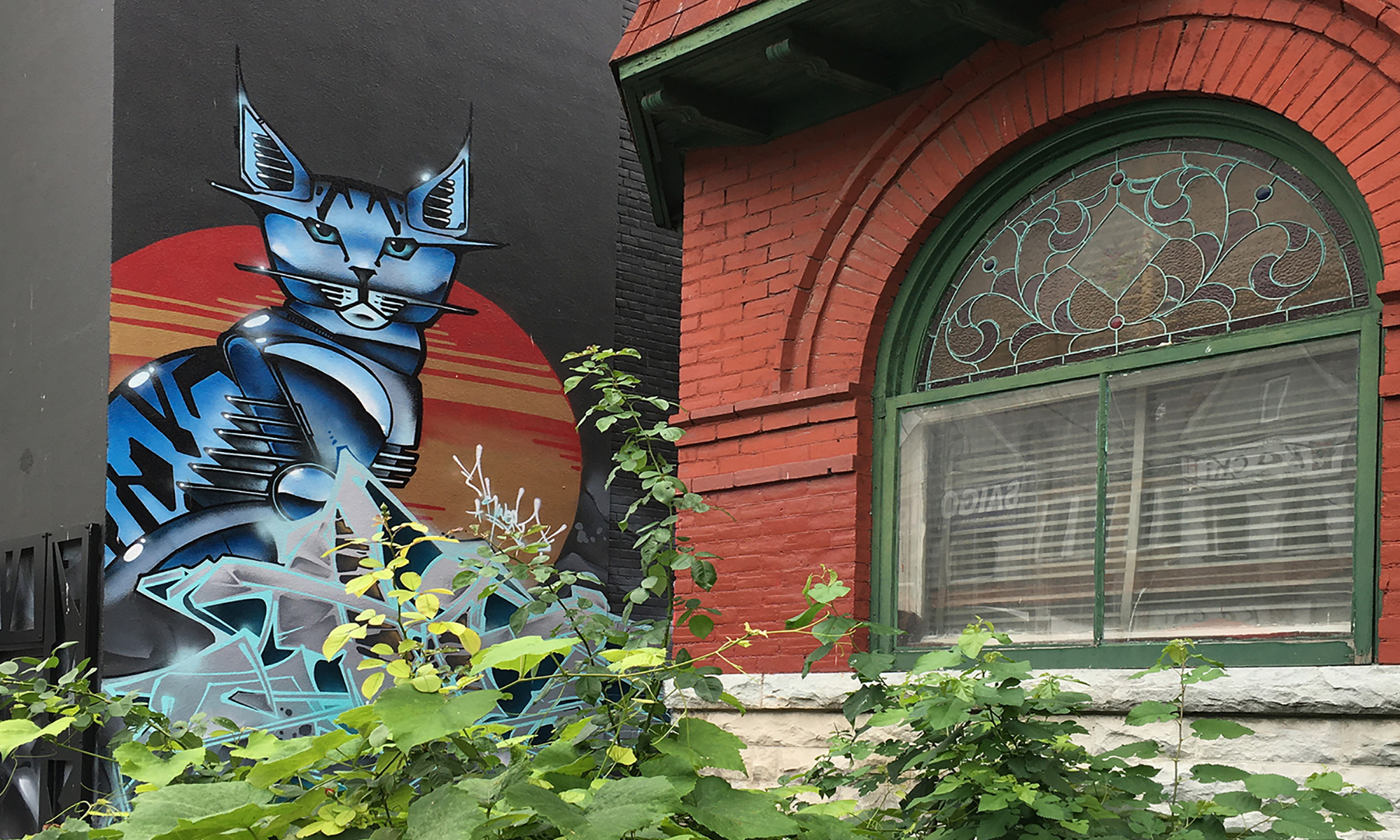Kensington’s Marketplace Culture 1970s-Present
From the 1970s to present, Kensington’s unique market place culture has been preserved through community mobilization efforts within the greater metropolis and promoted through representations in popular culture.
Marketplace Culture and Urban Expansion
Kensington currently holds the unique status of Toronto’s only outdoor market with an interior shopping district on Kensington Avenue, through Baldwin Street and along Augusta Avenue.[i] The neighbourhood is presently made up of a distinct milieu of residential, commercial and institutional buildings which include specialty, vintage and ethnic stores as well as galleries and cultural institutions and has been aptly described as Toronto’s Vienna within Los Angeles.[ii] However, as early as the 1960s, homeowners, tenants and merchants faced external threats to the historical landscape and distinct market place culture of the neighbourhood. An early example was the 1966 Metro Expressway Plan, a joint initiative between the federal, Ontario Provincial and Toronto Municipal governments to construct a network of freeways for Metropolitan Toronto.[iii] Particularly concerning to residents of Kensington Market and surrounding neighbourhoods was the proposed Spadina Expressway which was expected to direct heavy traffic through the Cedarvale Ravine and down Spadina Avenue to Bloor Street.[iv] If completed, this new route would have carried traffic off of the expressway causing congestion on local streets. Grassroots opposition began in October 1969 when a coalition of students, academics, politicians formed the “Stop Spadina, Save Our City Co-ordinating Committee” (SSSOCCC) and launched a public campaign against the expressway project. In response to public pressure, Premier William Davis withdrew provincial support on June 3, 1971 stating that “If we are building a transportation system to serve the automobile…the Spadina Expressway would be a good place to start. But if we are building a transportation system to serve the people, the Spadina Expressway would be a good place to stop.”[v] Since 2004, Kensington residents and local businesses have taken active measures to preserve the market’s distinct pedestrian culture through the organization of monthly pedestrian Sundays. During these events, sections of Augusta St., Baldwin St. and Kensington Ave. are closed to vehicles, transforming the streets into a pedestrian mall and stage for live entertainment and games.[vi]
The Market in Popular Culture

One of the most famous depictions of Kensington’s unique market place culture in the 1970s and 1980s was King of Kensington, a CBC television sitcom airing 90 episodes between 1975 and 1980. The program starred Al Waxman as Larry King, a convenience store owner who regularly resolved neighbourhood issues ranging from preserving local landmarks to integrating recent immigrants into the community.[vii] Most importantly, the show’s depiction of Kensington Market as a resilient urban village within a growing metropolitan center realistically mirrored the community’s resistance to urban renewal and freeway construction plans that were destroying similar communities in other parts of Toronto.[viii] In 2002, the CBC produced a series of television specials called Tuning In which reflected on significant contributions to Canadian broadcasting. The program argued for the authenticity of the image of the Market depicted in King of Kensington and suggested that the values depicted in the program such as its celebration of ethnic diversity and entrepreneurial spirit survive as prevailing attitudes within the Kensington community today.[ix] Collectively, these developments in community mobilization and pop culture demonstrate that immigrant entrepreneurism and bohemian culture have remained pillars of community life throughout the past forty years.
[i] Shaw, 7.
[ii] “Kensington Market in Toronto – Ontario, Canada .” Travel & Events. Posted Sep 27, 2009. Canadian Tourism YouTube Channel. Sep 27, 2009. Web, http://www.youtube.com/watch?v=8Lwb7y1NwbI.
[iii] Shaw, 63.
[iv] Bradburn, Jamie. The Canadian Encyclopedia, “Toronto Feature: Spadina Expressway.” Last modified 2012. Accessed February 7, 2013. http://www.thecanadianencyclopedia.com/articles/toronto-feature-spadina-expressway.
[v] Ibid.
[vi] Levin, Laura, and Kim Solga. “The Drama Review.” Building Utopia: Performance and the Fantasy of Urban Renewal in Contemporary Toronto. 53. no. 3 (2008): 37-53. http://bf4dv7zn3u.search.serialssolutions.com.myaccess.library.utoronto.ca/?ctx_ver=Z39.88-2004&ctx_enc=info:ofi/enc:UTF-8&rfr_id=info:sid/summon.serialssolutions.com&rft_val_fmt=info:ofi/fmt:kev:mtx:journal&rft.genre=article&rft.atitle=Building utopia: performance and fantasy of urban renewal in contemporary Toronto&rft.jtitle=TDR (Cambridge, Mass.)&rft.au=Levin, Laura&rft.au=Solga, Kim&rft.date=2009-01-01&rft.pub=MIT Press Journals&rft.issn=1054-2043&rft.volume=53&rft.issue=3&rft.spage=37&rft.externalDBID=n/a&rft.externalDocID=208299404 (accessed February 7, 2013). 47.
[vii] Fireworks a ContentFilm Company, “Comedy Drama Series King of Kensington.” Accessed February 7, 2013. Accessed February 7, 2013. http://www.contentmediacorp.com/common/file.php/pg/localhost74/contentfilm.com/binaries/1914/King%20of%20Kensington.pdf
[viii] Matheson, Sarah A. “Ruling The Inner City: Television, Citizenship and King of Kensington.” Canadian Journal of Film Studies. 15. no. 1 (2006): 46-62. http://search.proquest.com.myaccess.library.utoronto.ca/docview/211526663/fulltextPDF?accountid=14771 (accessed February 7, 2013) 47.
[ix] Matheson, 46.
